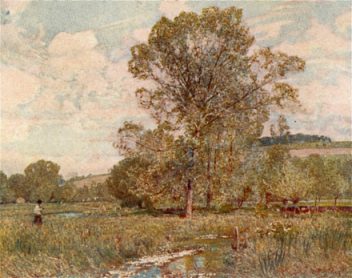|
use the arrow heads to navigate |
|
use the arrow heads to navigate |

A GREAT deal of discussion has taken place as to the advantage or otherwise of painting large pictures direct from Nature. A school., calling itself the "plein air" school, made this principle their party-cry. There may have been a reason for this, as landscape painting had become to a large extent a mere formula, a combination of recipes handed down by the old conventionalists, and had the odour of the studio; it wanted a breath of fresh air to revivify it. The "plein air" school did, in some respects, accomplish this, although its methods may have been pushed beyond legitimate limits; but all the faults combined of the new school were better than the artificial procedure of the older method. Painters awoke from their lethargy, and felt that in the freedom and individuality of the example of Constable and others a new era had arrived, in which it was possible for art to make advances parallel with progress in other departments of human achievements, though it was years before the more natural attitude received its due recognition. Artists now posed their peasants in the open air, and painted the effect of sunlight upon them, from immediate observation, and studied with direct vision the subtle effect of light, shade, and colour. Landscape painters took out their large canvases to Nature, and painted the subject before them on the spot. The difficulties were not lessened. But the question arose: "Was it possible by this method to secure the freshness of Nature, the sense of its atmosphere and illumination?"
Undoubtedly it was; but difficulties beset the path of these men., which have still to be faced and overcome. The great danger was of following the changing light instead of painting an effect of the moment. It frequently happened that, in the large landscapes so painted, the effects of sunshine were crossed, that is, that instead of being positive as in a sketch, they were distributed or expressed with more or less hesitation and lack of definite purpose. It was difficult to avoid falling into this error. The temptation was always present to paint the thing one saw at the moment, forgetting that five minutes later the sun would be blazing upon a surface which was now in shadow. If the effect of light on that portion of the picture were true to Nature, by the time you had painted it, the effect in another portion of the picture would be false. The only way out of the difficulty was to paint for a short time every day while the effect was on, at the same time correcting the values and having the courage to retain them while finishing the picture Of course, this plan would not insure that you had the colour scheme before you long enough to get a satisfactory result, but you would have your sketches to keep you right in respect to the large masses of your subject. If you ventured in the spring to paint a picture of apple-blossom, probably you would find that the blossoms would have faded before the picture was done.* Or you might paint a subject that mainly depends upon its colour The rain descends, your large canvas is brought indoors, and by the time the weather has again become suitable, the whole of your effect has changed it no longer offers the attractive combination of colour which
*I remember a painter, who was a determined "sticker" to Nature, starting a picture of apple blossom.
He commenced his picture well ahead of the full development of the flowers, and withdogged determination made up
his mind to "go for it." He painted the blossom with painstaking efforts to reallse it according to his
ideal of perfection. Conscientiously he altered his picture with the changing aspects of Nature, till, at length,
the blossom vanished, the full-grown leaves appeared,and the young fruit was developed. When I saw the picture
finished it was called 'GatheringApples" !
|
1 |